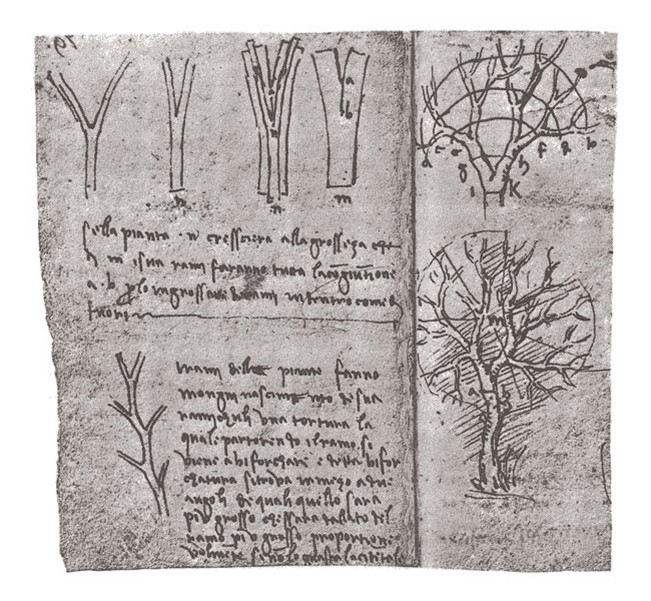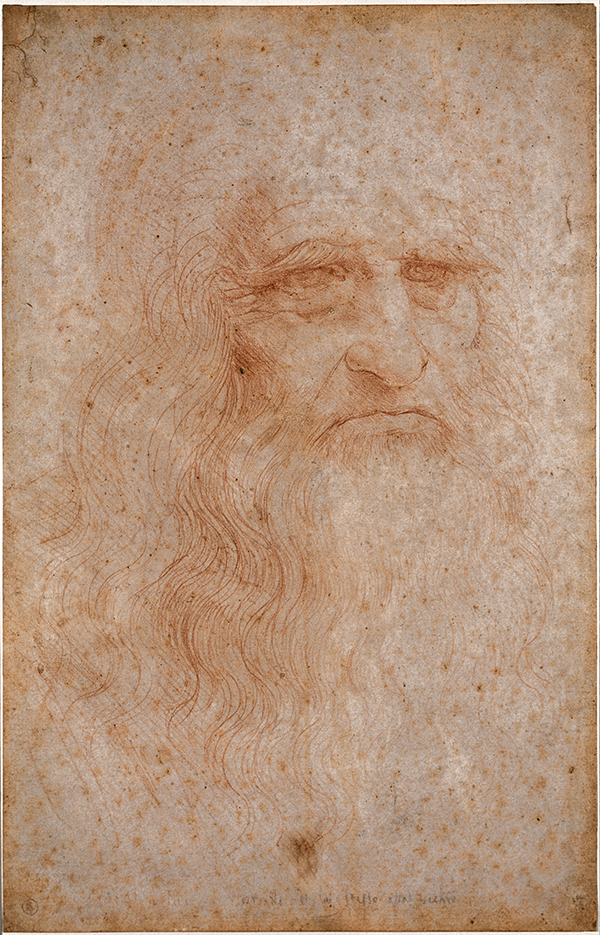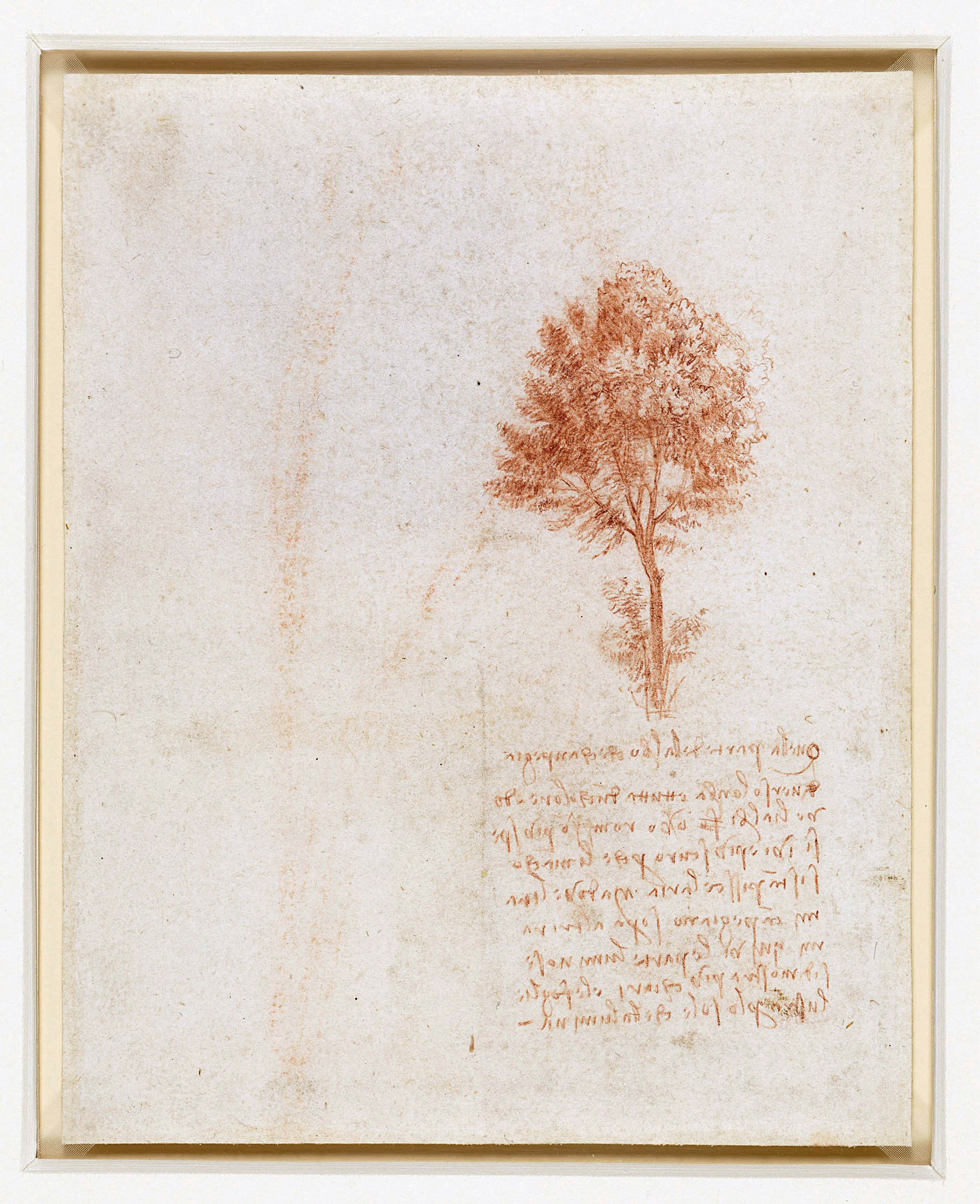
Credit: Leonardo da Vinci's Notebook. The British Library MS Viewer, 83. www.bl.uk/manuscripts/Viewer.aspx?ref=arundel_ms_263_f001r.
Leonardo da Vinci was one of our most brilliant thinkers. He’s known as an inventor, scientist, mathematician, architect, sculptor and, of course, painter of the most famous portrait in the world, the Mona Lisa. But unless you’re also a painter, you probably haven’t heard of Leonardo’s Rule of Trees.
Intent to paint them realistically, he carefully analyzed trees and recognized a pattern, which he encoded in this formula:
The thickness of the limbs that grow from a trunk, when combined, equals the thickness of the trunk. The thickness of all the branches that grow from each limb, equals the thickness of that limb.
Trees are fractal, meaning the pattern established in their larger branches repeats in smaller ones—so Leonardo’s rule applies all the way to the twigs. Using his formula to design his trees, his results were so convincing that other painters adopted his rule, too—and have used it since.
Recently, scientists wanted to figure out why this pattern exists. One researcher posited that trees evolved this way to withstand force, from wind or the weight of fruits. And in wind tunnel tests, this held up.
Other scientists, who hoped Leonardo’s rule might also hold for the vascular pattern of trees, found it did not. But he never intended it to—only to depict their outer structure. Which, 500 years later, it still does remarkably well.
Background
Synopsis: More than 500 years ago, a brilliant Renaissance polymath named Leonardo da Vinci formulated his “rule of trees” to help him more perfectly depict nature. For five centuries, artists have used this rule to add realism to their work. Recently, several studies have emerged that support, augment, or exclude this rule for use in modeling microscale three-dimensional (3D) fluid hydraulics of trees. But Leonardo created it for two-dimensional (2D) painters, and it has held up remarkably well for centuries.
- Leonardo di ser Piero da Vinci (Leonardo, son of ser Piero from Vinci), was born on April 15, 1452, near Vinci, Italy, about 25 mi (40 km) from Florence, and died in 1519 at age 67 in France.
- He was a polymath, exhibiting expertise in multiple fields, and was recognized as a painter, draftsman, engineer, scientist, inventor, theorist, sculptor and architect.
- He grew up near Vinci and was sent to Florence at age 14 to apprentice in artists’ studios, becoming a guild master at age 20.
- Acknowledged as one of the most influential painters in history, his best-known work, the Mona Lisa, was painted while he was in his 50s. And The Last Supper was painted by the time he turned 45.
- The Renaissance period began in the Tuscany region of central Italy, flourishing in Florence in the 15th and 16th centuries, so Leonardo lived in the midst of this cultural revival.
- Leonardo may well have been the most curious of all the “Renaissance men.”
- He was a genius, mastering multiple subjects including anatomy, astronomy, botany, cartography, painting and paleontology.
- He painstakingly recorded his observations of the natural world, along with assorted musings, shopping lists and ideas for inventions in his notebooks from the age of 26, in 1478, to the year before his death in 1518.
- A treasure trove from a man before his time, these 7,000 pages of notes were written in mirror script (right to left) by the left-handed author, requiring most people to hold them up to a mirror to read them.
- The British Museum has digitized 570 pages of these notes, which include anatomical and botanical observations, plans for flying machines and double hulled boats and ideas about ways to concentrate solar power, things that were not feasible to build with the materials available in his lifetime.
- In pursuit of artistic perfection, Leonardo compiled large sections of drawings and notes focused on details of the natural world.
- He studied optics and light to understand how light behaves in shadows.
- His anatomical observations came from his dissection of cadavers to better understand the musculature underlying human skin.

Self-portrait (presumed) of Leonardo da Vinci from around 1512, when he was 60 years old.
Credit: Leonardo da Vinci, public domain, via Wikimedia Commons - To hone his skills, he created many sketches of human limbs, especially hands.
- He studied human eyes closely, enabling him to capture the transparency of the pupil to make his art more lifelike.
- He tackled the plant world with the same intensity. He studied the ways foliage and trees grew to the point that he was able to create rules for how to draw them with the correct proportions, the most famous of which has been in use by artists and scientists for more than 500 years—“Leonardo’s Rule of Trees.”
- In 1888, Jean Paul Richter translated this rule from one page of Leonardo’s notes: “All the branches of a tree at every stage of its height when put together are equal in thickness to the trunk [below them].”
- See the first figure in this episode with its caption for a translation of Leonardo’s more detailed notes regarding the “rule of trees.”

Verso A tree, circa 1500, drawn by Leonardo da Vinci.
Credit: Leonardo da Vinci, public domain, via Wikimedia Commons
- Over the succeeding 500 years, artists used Leonardo’s convention to help them portray trees in their work, but no one ever explained why trees followed Leonardo’s rule.
- Mathematically, the rule can be stated as: D2 = ∑di2, where i = 1, 2, ... n, with “D” being the diameter of the mother branch (or trunk) and “d” being the diameter of the “i” number of daughter branches. The exponent 2 has been found to vary with species from 1.8 to 2.3, but the general formula has held up over time.
- Early on, botanists hypothesized that the rule worked because of the vascular requirements for trees to pump water from the roots to the leaves (ED-284 How Trees Lift Water) for photosynthesis, extrapolating the rule to suggest it also held up for vein diameter throughout a tree.
- In 2011, a French physicist who studies the fluid mechanics of air flow around objects like buildings tackled the question of why the “rule of trees” works. He questioned the validity of the vascular explanation.
- He reasoned that trees are self-similar (fractal) structures, and that branch diameters are optimized to reduce wind-induced loads.
- First, he modeled the probability of a branch breaking, then he modeled the thickness required to prevent a branch from breaking and came up with the 1.8-to-2.3 range for the exponent in Leonardo’s equation from both experiments.
- This means that the best engineering design for a tree that must withstand the bending stresses of high winds, ice and snow loads or even the weight of its fruit, is Leonardo’s rule. It is an elegant and simple explanation for Leonardo’s rule.
- In 2022, Russian scientists used 2D image analysis to augment Leonardo’s Rule of Trees.
- Their work suggests that when projecting trees onto 2D planes, it is not just cross-sectional diameter, but also the length of the branches that must be considered in the calculation.
- This twist removes the variability of the exponent (1.8–2.3) in Leonardo’s rule, as calculations can be made for the branching behavior of deciduous species with both slender branches and robust branches using the new formula (conifers are still under analysis).
- So 2D artists like painters can now calculate how far along a limb to illustrate branching as well as how thick those branches should be.

Photograph of a beautiful tree in Germany.
Credit: Dietmar Rabich, CC BY-SA 4.0, via Wikimedia Commons
- In past decades, as computing enabled 3D modeling of trees and their functions for biomass and carbon estimations in forests, scientists also adopted Leonardo’s Rule of Trees for a variety of characteristics, but a recent study suggests the time-honored rule may not be applicable for fine-scaled work in 3D.
- In 2023, scientists from Wales and Sweden showed that Leonardo’s rule does not hold up for 3D modeling of the vascular channels that transport water through trees within its branches.
- A tree’s vascular system must maintain hydraulic resistance for water and nutrients to move from roots to leaves. At some point toward its extremities, scaling according to Leonardo’s rule breaks down, and hydraulic resistance takes over to dictate microscale branching.
- Of course, Leonardo created his rule for artists to use for 2D representations of trees, so it was the scientists who made the leap to apply the proportional relationship for other purposes that were using it wrong.
- Americans celebrate Arbor Day as the last Friday of April, so plant a tree!
- But think about the implications. Plan for the long term within communities.
- In Texas with its hot climate, Arbor Day is celebrated on the first Friday in November.

